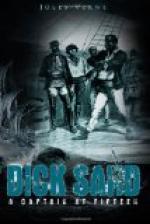In fact, the trader had reason to fear, and we know that, some years after, Cameron to the south and Stanley to the north, were going to explore these little-known provinces of the west, describe the permanent monstrosities of the trade, unveil the guilty complicities of foreign agents, and make the responsibility fall on the right parties.
Neither Alvez nor the mongrel could know anything yet of this exploration of Cameron’s and of Stanley’s; but what they did know, what they said, what Mrs. Weldon heard, and what was of such great interest to her—in a word, what had sustained her in her refusal to subscribe at once to Negoro’s demands, was this:
Before long, very probably, Dr. David Livingstone would arrive at Kazounde.
Now, the arrival of Livingstone with his escort, the influence which the great traveler enjoyed in Africa, the concourse of Portuguese authorities from Angola that could not fail to meet him, all that might bring about the deliverance of Mrs. Weldon and hers, in spite of Negoro, in spite of Alvez. It was perhaps their restoration to their country within a short time, and without James W. Weldon risking his life in a journey, the result of which could only be deplorable.
But was there any probability that Dr. Livingstone would soon visit that part of the continent? Yes, for in following that missionary tour, he was going to complete the exploration of Central Africa.
We know the heroic life of this son of the tea merchant, who lived in Blantyre, a village in the county of Lanark. Born on the 13th of March, 1813, David Livingstone, the second of six children, became, by force of study, both a theologian and doctor. After making his novitiate in the “London Missionary Society,” he embarked for the Cape in 1840, with the intention of joining the missionary Moffat in Southern Africa.
From the Cape, the future traveler repaired to the country of the Bechnanas, which he explored for the first time, returned to Kuruman and married Moffat’s daughter, that brave companion who would be worthy of him. In 1843 he founded a mission in the valley of the Mabotsa.
Four years later, we find him established at Kolobeng, two hundred and twenty-five miles to the north of Kuruman, in the country of the Bechnanas.
Two years after, in 1849, Livingstone left Kolobeng with his wife, his three children and two friends, Messrs. Oswell and Murray. August 1st, of the same year, he discovered Lake N’gami, and returned to Kolobeng, by descending the Zouga.
In this journey Livingstone, stopped by the bad will of the natives, had not passed beyond the N’gami. A second attempt was not more fortunate. A third must succeed. Then, taking a northern route, again with his family and Mr. Oswell, after frightful sufferings (for lack of food, for lack of water) that almost cost him the lives of his children, he reached the country of the Makalolos beside the Chobe, a branch of the Zambezi. The chief, Sebituane, joined him at Linyanti. At the end of June, 1851, the Zambezi was discovered, and the doctor returned to the Cape to bring his family to England.




